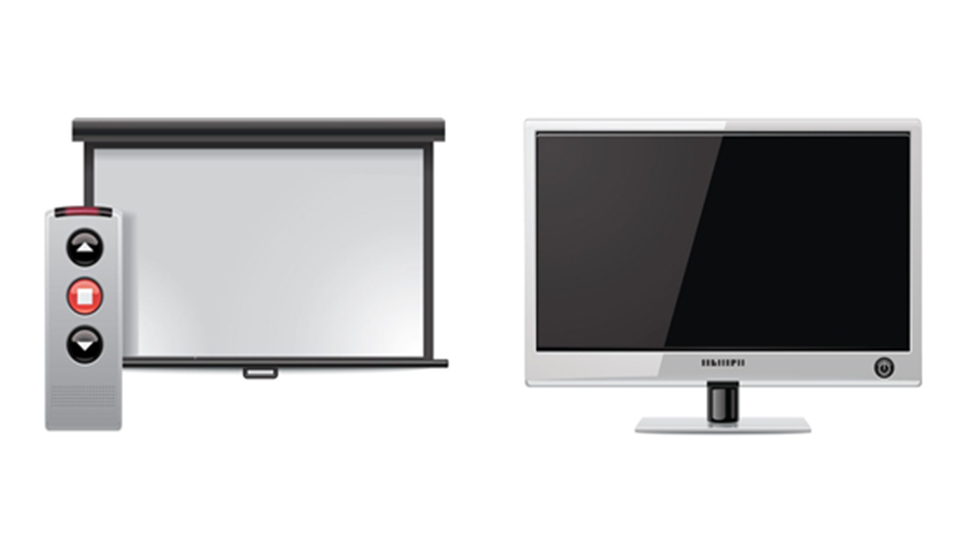
Home Theater Display Types
Depending on whom you ask you will get varying responses on what the most important part of a home theater is. For me it has always been the display you choose. But how do you choose the display that is right for you? In this article I won’t be getting overly technical, but rather providing you with an overall understanding of the advantages and disadvantages that come with the varying display technologies.
There are 6 types of displays for your Home Theater:
- LCD (CCFL backlight)
- LCD LED
- OLED
- Plasma
- DLP Rear Projection
- Projectors
LCD
LCD’s (Liquid Crystal Displays) are everywhere, most flat panel TV’s in circulation today are standard LCD’s. They offer good performance in well-lit areas, fast response times, and sizes ranging from 19”-65”. LCD’s are lit with CCFLs (Cold Cathode Fluorescent Lamps), so there power consumption decent but not as low as an LED set. These displays are cheaper now as they are being phased out and being replaced by newer LED TV’s.
Advantages
- Super low prices
- Excellent picture quality
- Low power consumption
- Decent black levels
- Thin
- Wide range of sizes
Disadvantages
- CCFL lamps can’t produce the inky black levels of LED, and Plasma displays
- Backlighting can become noticeable in dark room home theater setting
- Often suffer from light bleeding along the edges of the screen
LED
LED (Light Emitting Diode) TV’s are the current king of the Television industry. They are LCD screens with LEDs for backlighting instead of CCFLs. The term “LED” refers to the lights used in the display. LED lights are tiny, and require a ridiculously low amount of power. An LED TV generally offers all the advantages of a standard LCD along with increased black level performance, much lower power consumption, and even thinner displays.
There are two types of LED TV’s. Edge-lit models, and Local dimming models:
Edge-lit LED TV’s have their LEDs located around the edges of the screen.
Local dimming LED models have their LEDs located behind the screen.
Local Dimming models can turn their LEDs off and on independently depending on what is being displayed. In theory local dimming should be the best way to watch, but that is not always the case. Be careful to test out any local dimming display. Make sure you are satisfied with the image, as there can be light blooming around light colored objects on dark backgrounds.
Advantages
- Superior black level performance
- Superior colors
- Excellent picture quality
- Super thin and light
- Ultra low power consumption
- Perform great in well-lit and dark room settings
- Last forever
- Wide range of sizes
Disadvantages
- Can suffer from edge light bleeding and blooming
OLED
OLED (Organic Light Emitting Diode) TV’s are the new kid on the block. For years the technology has been view as something of a great white buffalo. It was locked up in a legal battle for a while, and now suffers from a tough manufacturing process. It unquestionably offers the best image quality available today. Offering truly lifelike images, with true black, and absurd contrast ratios. If you can afford one, there is nothing better.
Advantages
- The best black level performance
- The best colors
- The best picture quality
- Ultra low power consumption
- Perform great in well-lit and dark room settings
- Faster refresh rate, better contrast and better color reproduction
- Thin and light: There are models that stick to the wall with magnets
- Better viewing angles
Disadvantages
- Price
- Size: currently there are limited size options
Plasma
Plasma TV’s have been around for a while now and they are still hanging on. Offering superior black levels and color performance, Plasma TV’s are a great choice for dark Home Theater Situations. They also generally only come in larger sizes (50 inches+). Plasmas are not as popular as LCDs for a few reasons. They consume significantly more power, and do not perform well in well-lit areas as the picture tends to wash out. They are also more prone to image burn. Great strides have been made towards eliminating burn in, but it is still an issue.
Advantages
- Superior black level performance
- Superior colors
- Low prices
- Excellent picture quality
Disadvantages
- Limited size choices (generally 50 inches and up only)
- Perform horribly in well-lit areas
- Have shorter life span then the competition
- Still susceptible to image burn in
- Thicker then LCD based TV’s
- Power hogs
- 720p models still being sold
Rear Projection
Rear projection TV’s were popular up until around 2005. They could offer a really big image for a fairly affordable price. The problem with them came with the technology and its limitations.
Rear Projection sets are basically a projector inside of a box. The image is projected onto the screen from behind as opposed to from the front like a standard projector. This offered the appearance and form factor of a TV, with larger screen sizes then were available from LCD or old CRT tube TV’s at the time. However the technology has some fatal flaws that have essentially done it in.
Advantages
- No real advantages anymore
Disadvantages
- Due to the image being projected onto the screen from behind, these TV’s tend to be huge and heavy when compared to LCD, or Plasma
- They perform horribly in well-lit areas
- They have a much shorter bulb life then the competition
- They are more prone to breaking do to their moving parts
- They require warm up, and cool down times
- Image quality lags behind all other types of displays
Projectors
Projectors have been around forever! I’m sure you have seen them in every movie theater around the world. While they are the oldest tech of the group, they certainly are not going anywhere anytime soon.
Projectors can throw up a HUGE image, much bigger than any of the competing technologies. There are two main types of home theater projectors. They are LCD, and DLP projectors. I won’t get into the specifics of the technology in this article, but I will say that I tend to lean heavily towards DLP projectors.
Projectors are hands down the best way to watch movies in your Home Theater! I personally have owned two and loved every second of it. They are also great for some extra-large gaming sessions.
So if projectors are so great why doesn’t everyone have one?
Well for one they are often completely impractical for a persons living situation, and they generally require a ton of space to run properly. A projector needs to be a certain distance away from it’s screen to cast a properly sized image. This is called ‘throw distance’, and there is no real way around it. They also require gigantic fixed or drop down screens. If you want a 120” viewing area, you have to have space to mount a screen that size. The upkeep on projectors can also be expensive, their bulbs burn out much quicker than any of the competition. Replacing a bulb can cost hundreds of dollars depending on your make and model.
If you decide to go with a projector you should also be conscious of the fact that the image will completely wash out in sunlight or in well-lit rooms. I recommend having a pull down projector screen in conjunction with a LCD or Plasma TV. This way you can watch TV and game without the hassle of darkening your entire room.
You will also need to factor in the screen cost into your budget. Screens vary wildly in price, and are sorted by ‘Gain’. The Gain determines how reflective the screen is. For a Home Theater you will want to look for a screen with its Gain at or around 1.0.
Advantages
- HUGE and I mean HUGE image possibilities
- Great image quality
- Still the best way to watch movies
- Can find deals on cheap HD projectors and screens
- Great for dedicated Home Theater
Disadvantages
- Absolutely terrible in well-lit areas
- Short bulb life
- Require a ton of space, and often screen mounting
- Components have to be routed to projector
- Bulbs can be very expensive
- Quality projectors can cost thousands
- Screen adds cost
- More prone to breaking do to their moving parts
- Require warm up, and cool down periods
- Can require professional calibration to get a proper picture
If you use this information along with your budget you can really narrow the options down to a few displays. It is always important to go out and test any TV or projector you are interested in before you buy it. All the major retailers are set up to make this as easy as possible. Online reviews are a good guideline but what looks good to someone else, may not look good to you.

